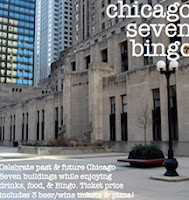It kicks off Friday morning, March 1st, with the SEAOI 2013 Trade Show at the University
 Club, Rick Valicenti presenting a keynote for the two-day Chicago Creative Expo at the Cultural Center, and, in the evening, new IIT College of Architecture Dean Wiel Arets treading on Frank Lloyd Wright turf with A Wonderful World, a lecture at Unity Temple in Oak Park.
Club, Rick Valicenti presenting a keynote for the two-day Chicago Creative Expo at the Cultural Center, and, in the evening, new IIT College of Architecture Dean Wiel Arets treading on Frank Lloyd Wright turf with A Wonderful World, a lecture at Unity Temple in Oak Park.March also includes appearances of two world renowned architects, with Dominique
 Perrault, talking about The Disappearance of Architecture: Between Presence and Absence, at IIT's Wishnick Auditorium on the 27th, while 2012 Pritzker Prize winner Wang Shu appears at Rubloff Auditorium for the Architecture and Design Society of the Art Institute on Thursday, the 28th.
Perrault, talking about The Disappearance of Architecture: Between Presence and Absence, at IIT's Wishnick Auditorium on the 27th, while 2012 Pritzker Prize winner Wang Shu appears at Rubloff Auditorium for the Architecture and Design Society of the Art Institute on Thursday, the 28th.On the academics front, there's Mirko Zardini, Executive Director of the Canadian Centre for Architecture, Monday the 11th at UIC, which also hosts Alessandra Ponte of L'École d’architecture de l'Université de Montréal on the 18th, while over at IIT, Kenneth Frampton talks about The Past and Future Prospects for Architectural Education on the 14th
This month's theme for CAF's lunchtime lectures is Mod Squad Chicago, with Bauhaus and Beyond's Joan Gand talking about the Hidden Gems of Mid-Century, Keck and Keck on Wednesday the 6th, Richard Becker and Lisa Skolnick discussing Edward Dart's Ancel House on the 13th, and Chicago at Midcentury: Images by Lee Bey on the 20th.
March is Mies month (actually, in Chicago, every month is Mies month), with the celebration of the master's birthday 127th on the 13th at Crown Hall, where Christianne Lange lectures on Mies Van der Rohe in Krefeld on the 27th, Edward Windhorst talks about Mies van der Rohe and Historic Preservation: A Report
 and Prognosis at the Cultural Center on the 21st for Landmarks Illinois, and Windhorst joins up with his co-author Franz Schulze at CAF lunchtime on the 27th to talk about Rewriting the Life of Mies can der Rohe: New Perspectives after 25 years.
and Prognosis at the Cultural Center on the 21st for Landmarks Illinois, and Windhorst joins up with his co-author Franz Schulze at CAF lunchtime on the 27th to talk about Rewriting the Life of Mies can der Rohe: New Perspectives after 25 years.And, really, how many chances do you have to combine supporting Chicago's architectural history with Bingo? Well, Preservation Chicago will be offering up just such a combination with their Chicago Seven Bingo fundraiser, on, appropriately enough, the 7th, anticipating the release of this year's list of the seven most endangered buildings the following week.
Tuesday the 5th, Pecha Kucha returns to Martyr's for its Volume #25. For its monthly dinner meeting, SEOAI has John R. Hillman talking about the engineering of the 35th Street Pedestrian Bridge over Lake Shore Drive on the 12th at the Parthenon, the same evening Lynn Allyn Young is over at the Glessner House Museum to talk about her book, Beautiful Dreamer - The Completed Works and Unfilled plans of Sculptor Lorado Taft .
Mel Buchanan recounts the story of Grete Marks: When Modernism was Degenerate, Thursday the 7th at Second Presbyterian Meanwhile, over at the Driehaus Museum on the 14th, Rolf Achilles discusses the lesser-known stained glass artisans who created Great Midwestern Panes.
I'm sure we'll be adding even more, but even now there are nearly fifty great items to check out on the March Calendar of Chicago Architectural Events.















































